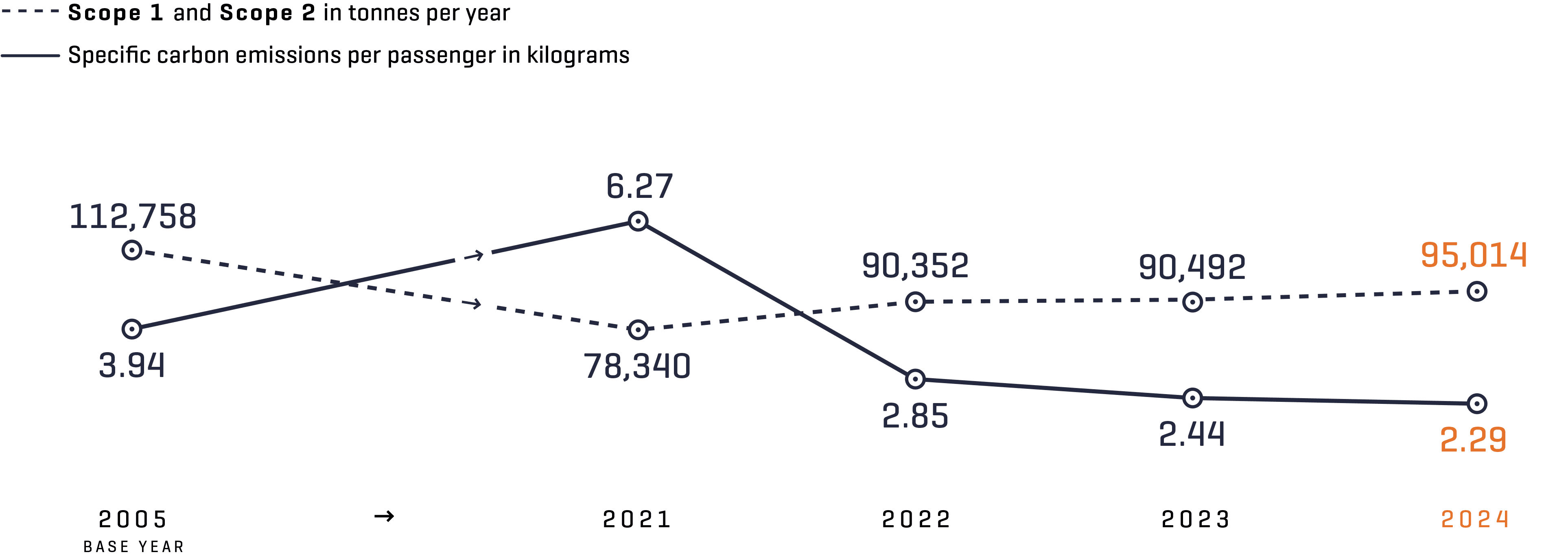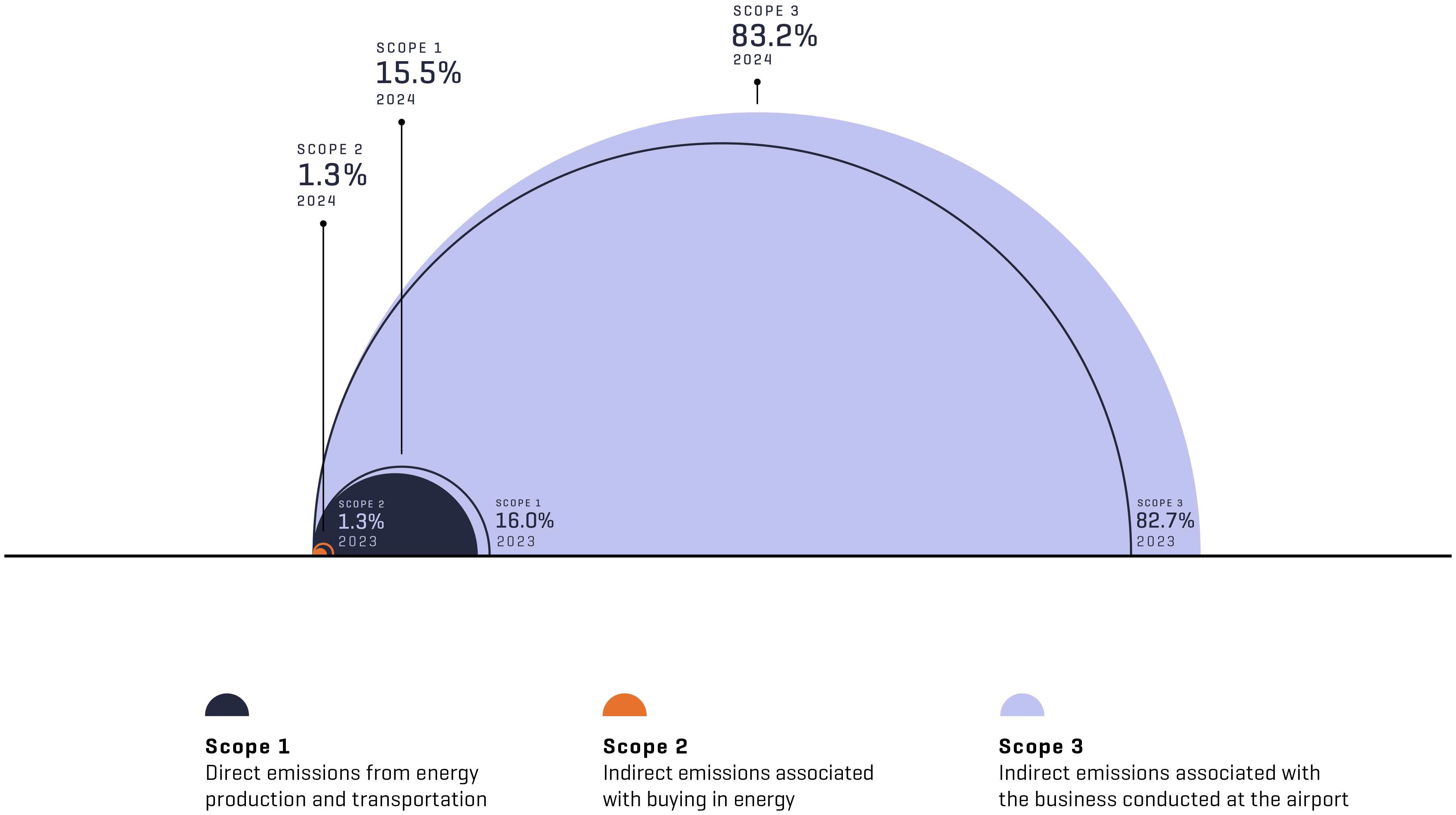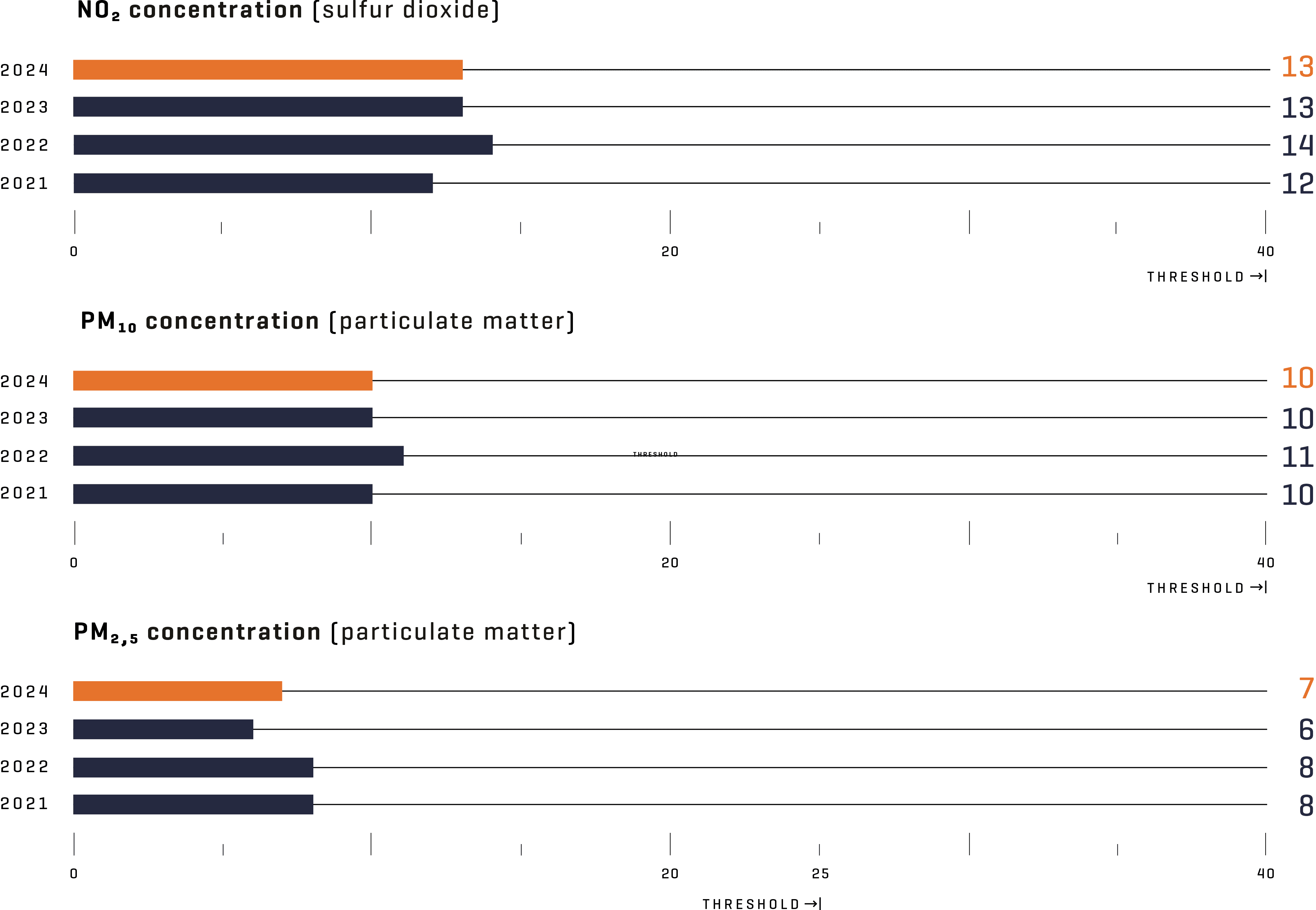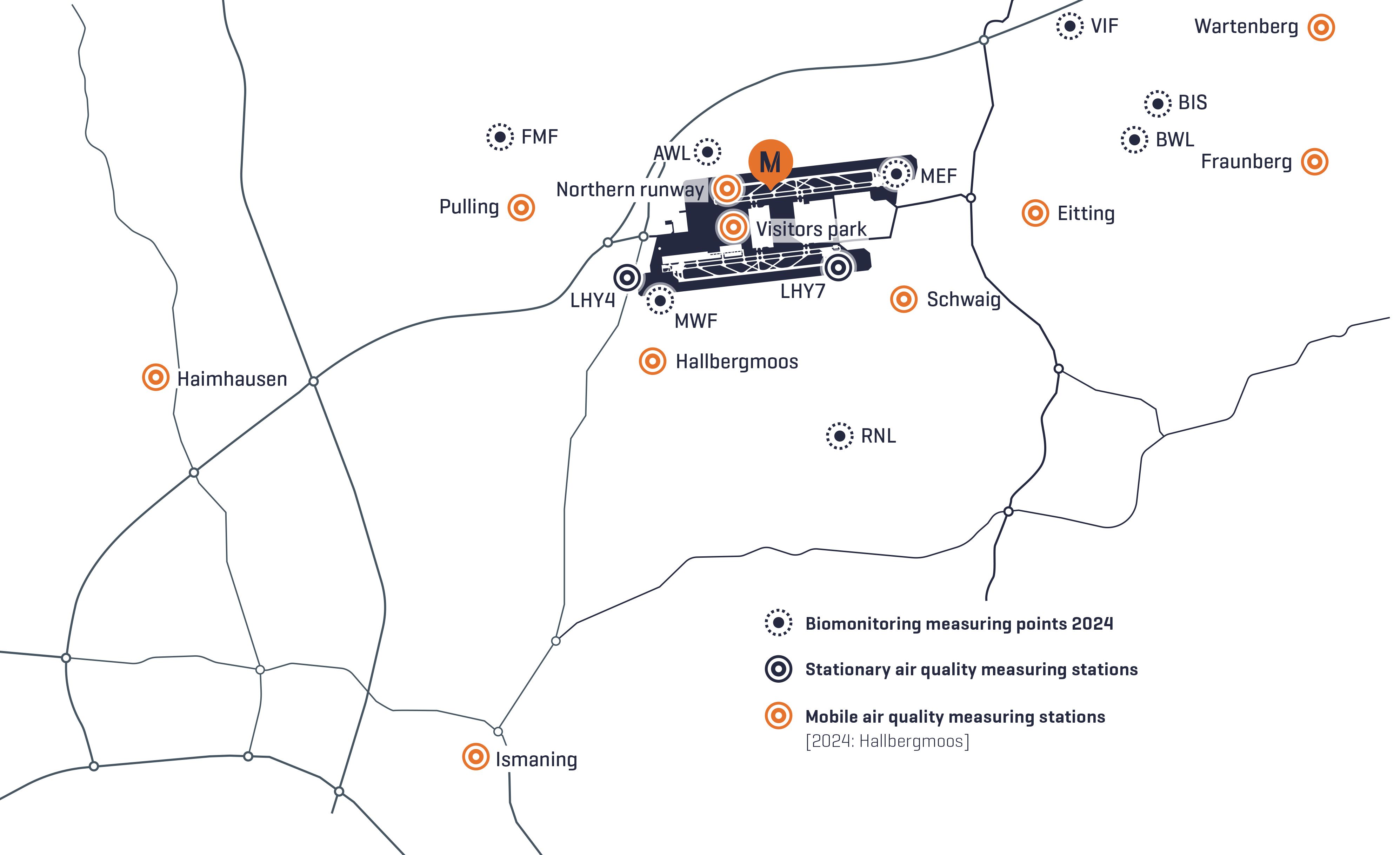Climate protection
Carbon savings: our path to Net Zero
With passenger figures increasing by approximately 12 percent in 2024, greenhouse gas emissions attributable to Munich Airport (Scope 1 and 2) also rose – by around five percent to 95,014 tons of CO₂. A positive contribution came from 19 energy efficiency measures, into which we invested approximately €1.5 million in 2024. Optimizations – for example in ventilation or heating systems – achieved recurring annual savings of 3,047 tons of CO₂. The number of measures implemented since 2005 now totals 370. Together, they have reduced CO₂ emissions by more than 61,000 tons per year and have prevented a significant increase in emissions – despite infrastructure expansion on the airport campus. Following the peaks during the COVID years 2020 and 2021, the rise in passenger figures was accompanied by a continued decline in specific CO₂ emissions per air passenger, which fell to 2.29 kilograms (Scope 1 and 2) in 2024. Compared to the 2005 baseline of 3.94 kilograms, this represents a reduction of approximately 42 percent.
The significant reduction in district heating supply led to an increased demand for heat from peak-load boilers. The Zolling coal power station has gone offline, and conversion work is currently underway to recommission it using renewable energy sources. Full heat volumes from the district heating network are expected to be available again in five years.
CO₂ emissions


Carbon footprint: a complex math problem
The operation of a large infrastructure facility involves emissions from a wide variety of polluters. They are all included in the balancing of an airport’s greenhouse gas emissions. Emissions from air traffic in the landing-and-take-off cycle (aircraft landing and taking off at altitudes up to 3,000 feet) account for the largest share. The carbon footprint provides the basis for recording all forms of emissions and lends itself to comparison. It breaks down all greenhouse gas emissions that can be attributed to the airport into three different sources (scopes) according to an international standard, the «Greenhouse Gas Protocol».
Greenhouse Gas Emissions


Scope 1 and Scope 2
Energy concept: multiple solution approaches
In the future, Munich Airport wants to use as many available resources in the region as possible for its energy supply. To achieve this, photovoltaic systems with a total output of 50 megawatts are to go into operation on parking garages, freight buildings, and suitable open spaces starting in 2030. Since the end of 2024, three new photovoltaic systems located on the rooftops of parking garages P43, P44, and P22 have been in regular operation. With an installed capacity of approximately 4.8 megawatts, they reduce our CO₂ footprint by around 2,200 tons of C02 per year on a recurring basis. Together with the existing systems, they produce nearly seven gigawatt hours of solar power annually. Munich Airport also plans to conclude electricity supply contracts with offshore wind farms to further increase the share of renewable energy in the current energy mix. A corresponding tender is currently being prepared. In addition to climate protection, high energy prices and the need to avoid dependence on Russian natural gas are strong arguments for promoting energy supply autonomy.
Goal: Expansion of photovoltaic systems
20 MW on roof areas
30 MW on open areas
Over 50,000 MWh of solar power
Equivalent to the electricity consumption of almost 15,000 households or a quarter of Munich Airport’s electricity consumption in the pre-crisis year 2019
Over 19,000 tons of CO₂ savings per year
The conversion of the airport’s own combined heat and power plant to externally sourced biomethane as part of the Net Zero Strategy represents an important building block in achieving our CO₂ reduction targets. A concrete decision on the type of implementation of the use of biomethane, the time frame, and possible partners and suppliers has not yet been made.
Top 3 measures
LEDs reduce energy consumption
As in the previous year, the greatest savings were achieved in the lighting category. Most notably, the changeover of linear and cross lighting fixtures in Terminal 1 made a significant contribution to reducing electricity consumption. In addition to replacing old light sources with LEDs, the optimization of lighting controls – such as daylight-dependent regulation, presence-based control, and minimum brightness settings (e.g. in parking garage P51) – as well as the changeover of advertising lighting and elevator systems, also contributed to a reduction in CO₂.
Electrification of ground handling vehicles increases
The replacement of a total of 123 vehicles – including lift trucks, stairs, towing vehicles, small transporters, and for the first time in this reporting year, buses – resulted in major diesel and gasoline savings for AeroGround, a Munich Airport subsidiary. Fuel consumption from just 24 towing vehicles and ten electric buses alone was reduced by approximately 219,000 liters of diesel per year.
Optimization of the ventilation systems
Campus-wide optimization of ventilation systems is continuing. A key milestone in 2024 was the conversion of four air handling units in Terminal 1: more efficient fan technology, new frequency converters, new heat recovery media, and the expansion of existing silencers helped save approximately 900 megawatt hours of electricity annually. The changeover of four additional units is planned for 2025. In Terminal 2, Munich Airport achieved significant savings through improved control of CO₂ levels in indoor air and the recirculation mode.
Excerpt from energy efficiency measures completed in 2024 (Scope 1 and 2)
Issue | Measure | CO₂ savings per year in tons |
|---|---|---|
Air conditioning | Changeover of rooftop air handling units in Terminal 1 (construction phase 1) | 493 |
Changeover of ventilation systems and chiller in Terminal 2 | 345 | |
Lighting
| Changeover from linear fixtures to LED technology in Terminal 1 | 321 |
Changeover to LED technology in Terminal 2 | 289 | |
Changeover from cross lighting fixtures to LED technology in Terminal 1 | 243 | |
Vehicles | Electrification of vehicle pool | 796 |
Electromobility: proportion grows to 41 percent
Munich Airport has already tested various alternative drive concepts. These include the opening of the world’s first public hydrogen filling station in 1999, as well as trials with biogas, bioethanol, and bio- and C.A.R.E. diesel (C.A.R.E. stands for CO₂ Reduction, Arctic Grade, Renewable, Emission Reduction). Currently, we operate 183 passenger cars and small transporters, as well as 440 ground handling and specialized vehicles, with electric drive systems. By 2030, electric vehicles should comprise the lion’s share of the vehicle pool. In 2024, investments in the procurement of electric vehicles increased again, particularly in the area of handling. Their proportion has grown to 41 percent. Approximately 26 percent of all CO₂ savings in 2024 were achieved in the vehicle category.
The German Federal Ministry of Digital Affairs and Transport has awarded Munich Airport funding amounting to almost 24 million euros. This funding supports the acquisition of up to 72 electrically powered passenger buses, including the necessary charging infrastructure at Munich Airport. AeroGround, a subsidiary of FMG that is responsible for passenger and crew transportation at Munich Airport, plans to convert its entire bus fleet to electric drive by 2025 and invest up to 60 million euros in the process. The first ten electric solo passenger buses arrived in September 2024, followed by another 27 electric buses by the end of 2024. Electric drive systems are considered particularly efficient for apron operations, which are characterized by many short distances and low speeds. In addition, the associated company Enteisen und Flugzeugschleppen (De-Icing and Aircraft Towing) at Flughafen München GmbH has ordered 14 fully electric aircraft tugs, which are scheduled for delivery by 2028.
To date, FMG has installed over 600 charging points for both its own pool vehicles as well as for airlines, authorities, the rental car and car-sharing sector, air travelers, and partially for ground handling equipment. By 2030, the plan is to expand the existing charging infrastructure by several thousand charging points. More than 1,000 standard charging points and twenty fast-charging points are planned to be newly installed in the public area alone. One example is the installation of 260 charging points in parking garage P44. These charging stations are powered by a rooftop photovoltaic system combined with a high-performance energy storage unit to efficiently utilize the generated electricity. At the heart of the system is an intelligent charging management system to ensure that the electric vehicles are charged as needed. We are working closely with industry partners to drive the further expansion of electromobility across the entire airport site through innovative solutions.
Scope 3
DHL Express builds energy-efficient gateway
In 2022, DHL Express began construction of a new logistics center at Munich Airport. With this project, the company is setting new standards in logistics and sustainability. In addition to a large photovoltaic system to supply electricity for building operations, the building’s base load heating demand is covered by heat pumps in combination with connection to the existing district heating network for peak loads on the campus. Additional charging points have been installed to support the electric vehicle pool. This ensures that emissions from newly constructed infrastructure remain minimal.
Air quality: consistent monitoring
Nitrogen oxides and particulate matter: at a low level
As with CO₂, aircraft cause significantly more air pollutant emissions than ground traffic on the aprons and on access and service roads. It is not possible, however, to differentiate between the immissions metrologically. Nitrogen oxides and particulate matter are key factors in assessing air quality at the airport and in its environs. For the measurement of air pollutants, we operate one mobile and two stationary measuring stations. The stationary measuring stations in the west and east of the airport record the effects of pollutant sources from road and air traffic and other airport operations – superimposed on the background pollution of the Munich metropolitan area and the natural background concentration in the atmosphere. The mobile air quality measuring station is used to analyze air quality in the areas requested by various municipalities. Mobile measurements were once again conducted in 2024 at the Volksfestplatz in Hallbergmoos.
In 2024, the nitrogen dioxide concentrations at Munich Airport remained at a normal level for a suburban area. The Covid-19 pandemic brought about a significant decline in concentrations, which has continued despite increasing air traffic. The concentrations of particulate matter at Munich Airport are at a consistently low level and are characteristic of rural areas. Here we can see a clear meteorological dependency: Dry and hot weather favors higher levels of particulate matter. In 2024, all air quality monitoring stations recorded levels well below the applicable legal limits.
Pollutant concentrations at the measuring point to the east of the airport grounds
Annual average values in microgram/m³


Landing charges: emissions as the basis
FMG charges emissions-based landing charges. Our aim is to motivate engine manufacturers and aircraft builders to invest more in the development of aircraft that produce less in the way of pollutant emissions. Munich Airport is thus helping to better environmental quality in the surrounding area. Based on the types of aircraft that land, we are able to calculate pollutant emissions – as well as the greenhouse gas CO₂ – down to the individual engine and directly reflect technological progress.
Ultrafine particulate matter: a further topic of research
Air traffic is a source of ultrafine particles (UFPs). However, there is currently no objective standard for assessing particle concentrations and no limit values. In the vicinity of Munich Airport, the University of Bayreuth has been measuring the UFP concentration at the Stadtgärtnerei in Freising and at the Volksfestplatz in Hallbergmoos since spring 2021 on behalf of the Bavarian Ministry of the Environment. The Ministry of the Environment has already published the initial results for 2022–2023. Consequently, the concentrations in Freising and Hallbergmoos are at a similar level to those at the measuring stations of the Bavarian State Office for the Environment in Regensburg, Augsburg, and Munich. FMG supports the University of Bayreuth’s measurements with the mobile measuring station at the Hallbergmoos site and collects additional air quality parameters to help interpret the UFP concentrations. FMG does not carry out UFP measurements itself.
Organic honey: 30 bee colonies around the airport
Long-lasting pollutants can accumulate in the environment and therefore seep into the food chain. Munich Airport has been monitoring this situation for many years using a variety of methods. In 2024, plant pots with perennial ryegrass and kale were installed at eight measuring points in the surrounding area in order to investigate the contamination of feed and food in the area around the airport. No abnormalities were found. We also continued our honey monitoring efforts with 30 bee colonies around the airport. Munich Airport honey has been certified «organic» since 2023. It is the first honey from a German airport to meet the requirements of the EU Organic Regulation VO(EU) 2018/848 and bears both the EU organic label and the German organic label on its packaging.
Measuring points air quality and biomonitoring

